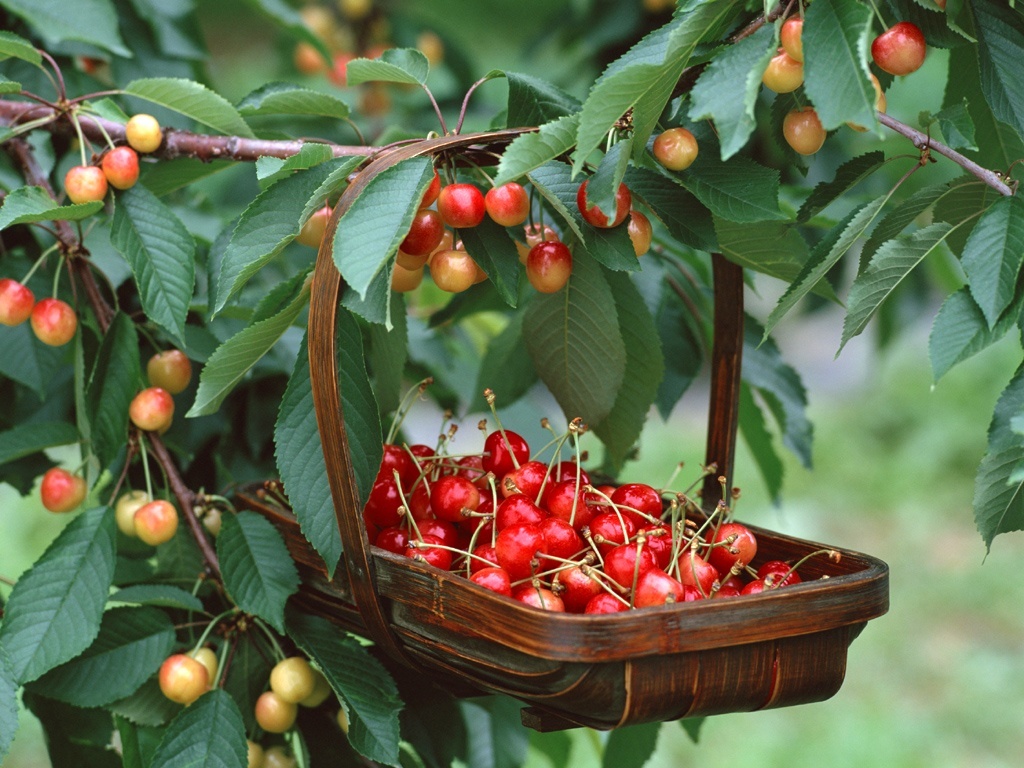Sweet cherry is a rather capricious culture, and until recently it seemed that it was impossible to grow it in central Russia. But the Fatezh variety is characterized by increased frost resistance and drought resistance.
Table of contents
Description of a grade of sweet cherry Fatezh
Cherry Fatezh varieties was bred in 2001 by the breeder A.I. Evstratovy on the basis of the All-Russian Breeding-Technological Institute of Horticulture and Nursery. The free pollination of the Leningrad yellow was used as a method of elimination.
This variety is zoned for the Central region, perfect for the suburbs. The cold resistance of cherries allows it to survive the changeable climate of central Russia, but Fatezh cannot withstand the severe cold of Siberia. The smallest frost resistance have tree buds.
Trees reach a height of 3-5 meters. The crown is spherical, rounded, sprawling, the branches grow either at right angles or directed downwards. The shoots are straight, thick, painted in brown.
Leaves of the large size, differ in the pointed, extended form. Along the edges of the sheet is framed by fine serrations. The surface is smooth, glossy, dark green.
Cherry flowers Fatezh painted white. Podovye ovaries are formed on the annual shoots and on the bouquet sprigs.
This variety belongs to the medium early, the first harvest can be obtained already at 4-5 year of life of the tree. Fruits reach full maturity in mid-July. From a young tree, whose age does not exceed 10 years, receive up to 30 kg of berries, then this indicator increases to 50 kg.
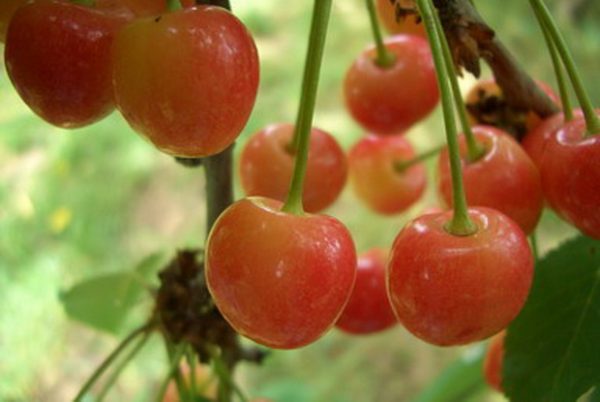
Characteristics of the fruit
Berries of Fatezh cherries are round, rather large, on average, their mass varies from 4 to 6 grams. The skin is smooth, shiny, red-yellow color. The flesh of such berries is dense, juicy, light pink in color. The stone is easily separated from the pulp, has an oval shape and a light shade.
The taste of fruit is sweet and sour. Tasting score is 4.5-4.7 points. Fatezh variety berries are characterized by a long shelf life and good transportability. Also, during heat treatment the peel of the fruit does not crack.
Advantages and disadvantages
- The tree quickly grows and begins to bring in crops as early as the 4th-5th year of life;
- In adulthood, the Fatezh sweet cherry can produce up to 50 kg of crop:
- Increased frost tolerance:
- Immunity to fungal diseases;
- These berries tolerate transportation, can be stored for a long time, besides, they have excellent taste.
- The tree is self-infertile, it needs pollinator to reproduce the crop;
- Propensity to gamble.
You may also be interested in the following varieties of cherries:
Planting and care
Before you put a sweet cherry on your site, you need to choose the right sapling. In order for a tree to quickly take root in a new place, you should follow the following recommendations:
- It is best to purchase seedlings in proven nurserieslocated in the area where cultivation is planned. Otherwise, the plant will have to go through the process of acclimatization.
- The main indicator of seedling health is a powerful, branched root system. The cut must necessarily have a light beige color;
- The crown of a seedling should consist of 3-4 branches, approximately 40 centimeters long;
- Seedlings aged 1-2 years are most likely to take root.
The correct choice of landing site is the key to a successful landing.
- Sweet cherry Fatezh needs good lighting and protection from gusty winds.It is best to choose the southern or south-western sides of the site.
- Also, this variety grows well in the hills, but not in the hills. You can lift the soil level yourself by sprinkling a layer of earth by 50 centimeters.
- In order to avoid stagnant water, it is recommended to choose places with deep groundwater.
Planting pit for cherries is prepared in the autumn, so that the soil could be drawn during the wintering season. The pits are pulled out at a distance of 3 meters from each other, their diameter is 80 centimeters, and the depth is 50-60. Then the bottom is loosened and 2 buckets of humus mixed with the upper, fertile layer of soil are poured into it.
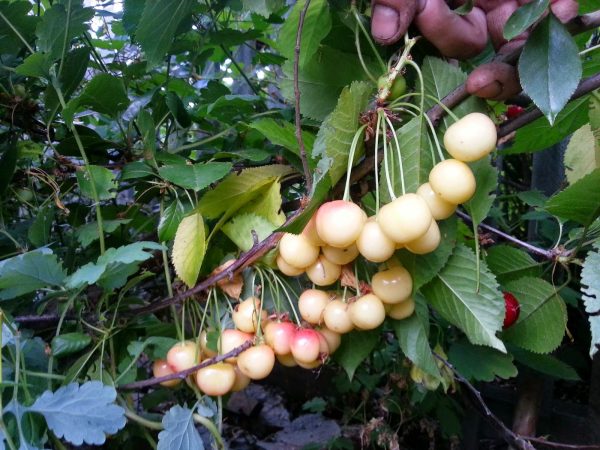
Before landing in the pit add:
- 1 kilogram of ash;
- 400 grams of superphosphate;
- 100 grams of sodium sulfate.
When planting cherries, gardeners usually adhere to the following algorithm of actions:
- For starters, set the peg, which will serve as a support for the seedling.
- In the center of the pit you need to build a mound and place a seedling on it, gently straightening the roots.
- Then the tree is tied to a support and gently covered with earth, gradually tamping it down. The root neck should be 3-5 centimeters above ground level.
- At the final stage, a roller is constructed from the ground and plentifully watered with a sweet cherry, then the soil is mulched with peat or humus.
Growing conditions
- Cherry is poured over 3 times per season, 30-40 liters of water are consumed for a young tree, and 50-60 for an adult.
- Crop.
- Cherry Fatezh is distinguished by active growth of shoots, and in order for the crown not to become very thick, it must be cut annually. This procedure is carried out in the spring, before buds begin to swell on the tree. Annual branches are cut into 1/5 part.
- After the tree reaches 5 years of age, the phase of intensive growth will cease, and during the formation of the crown, it will be necessary to remove the branches that grow inside the crown or excessively thickening shoots.
- In the autumn, it is necessary to carry out sanitary pruning, during which all diseased, dry or damaged branches will be removed.
- Cherry Fatezh, as well as other trees, needs timely and proper feeding.
- Before budding under the tree, 2 tablespoons of urea, potassium sulfate and the Agricol mineral complex, diluted in 20 liters of water, must be applied.
- After flowering sweet cherry needed strength to ripen the crop. A pristvolny circle is watered with 30 liters of water with 6 tablespoons of mineral fertilizer and 6 glasses of organic.
- After the harvest, 200 grams of superphosphate, 100 grams of mineral fertilizers and 100 grams of potassium sulfate are poured under each tree, then the cherry is poured abundantly.
- When the flower buds appear, the crown is sprayed with a growth stimulator.
- Fatezh also needs regular weeding and loosening the soil.
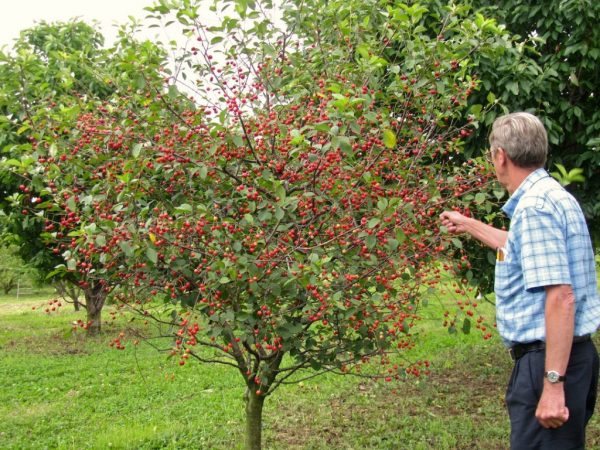
Cherry reproduction
Qualitative reproduction of cherries, that is, with the preservation of all signs of the desired variety, is possible only by vaccination. When growing a tree from a stone, it will not inherit the characteristics of the parent tree.
Most often, cherries are grafted onto cherries, but in this case, the stock, that is, the tree onto which the grafting is being done must be stable and resilient. You can also get a vaccination on cherries, this method is very popular among gardeners, because in most cases it ends with success, besides, it is possible to collect different crops from one tree.
Cherry can be grafted from early March to mid-September. During the procedure, you need to calculate the time so that the vaccine would have time to settle down before the onset of cold weather.. The best time is considered to be the spring period, when active sap flow occurs in the stock.
There are several ways of grafting cherries, but the best results are obtained by grafting copulation (cuttings).
To carry out grafting, it is necessary that the rootstock and graft be of the same thickness. It is best to take root cuttings, whose age does not exceed 2 years.
- On the prepared shoots with a sharp knife is made oblique cut, about 3 centimeters long.
- In the center of these cuts make tongues (splits), which will allow the cuttings to tightly connect.
- Bond together with a graft and a graft wrapped with tape, tape, plastic wrap or other similar material.
- Then, a plastic bag is put on the grafted cutting and is tied up just below the grafting site. In this state, the tree should be 2 weeks. During this time, the vaccination should take root and all supporting materials can be removed.
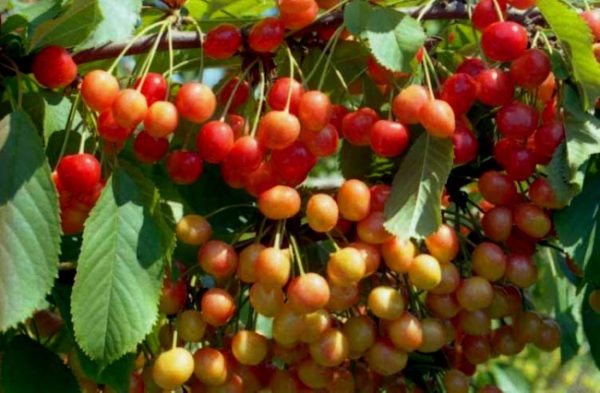
Peculiarities of this variety
- The main distinctive feature will be the color of Fatezh sweet cherry berries, it is significantly different from other popular varieties of such trees. Instead of the usual, burgundy or purple fruits have a light red shade with yellow spots.
- Fatezh also differs in its crown, which has a spherical shape, and the branches grow towards the bottom. Such a structure is not typical for cherry trees.
- Tree growth often stops at around 3 meters.while other varieties, on average, grow to 4.5-5 meters.
- The yield of the variety remains at the highest level; an adult tree can produce up to 50 kilograms of fruit.
Diseases and pests
The Fatezh sweet cherry variety is distinguished by good resistance to pests and many diseases, in particular, to moniliosis and coccomycosis. But such trees are prone to comedy.
Gum is a thick, sticky substance of amber color, which is released from the bark of a tree. There are several reasons for its occurrence:
- Wounds and injuries on the tree;
- Not neat pruning of branches;
- Frost;
- Pests;
- Excess moisture;
- Fungal diseases;
- An excess of nitrogen fertilizers or phytohormones.
As a prevention, you need to keep the old bark on the tree, because it serves as a reliable protection. It is also recommended to hold spring and autumn whitewashing the trunk, it will help avoid the occurrence of sunburn. And to protect the cherries from the winter cold and the appearance of cracks will help winding skeletal branches and trunk paper or matting.
If the disease still appears, the wound is cleaned with a knife until a healthy area appears, then this place is disinfected with copper sulfate solution and a thin layer of nigrol putty is applied with clean hands.
Fatezh is a godsend for a gardener who wants to grow sweet cherries in central Russia. This variety has good resistance and unpretentiousness to the climate. In addition, its fruits are distinguished by excellent taste and are perfect for commercial activities.
